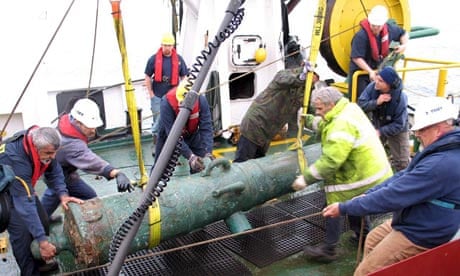Human remains have been found in the deep sea wreck of one of the mightiest and most advanced fighting ships to have served in the Royal Navy.
A skull and rib bones were discovered under a cannon by marine archaeologists investigating the wreck of HMS Victory - the direct predecessor of Nelson's flagship at the Battle of Trafalgar - which went down during violent storms in 1744.
In its day, the 1744 Victory was the biggest and most powerful ship in the world with a mighty 110 guns and fought during the War of the Austrian Succession. It is historically significant but also financially important - there could be as much as £700m worth of gold bullion on board.
The discovery of Victory - by some of the world's most successful marine marine archaeologists, Odyssey Marine Exploration - solved a 265-year mystery of where the ship went down when news was released a year ago.
Greg Stemm, chief executive officer of Odyssey, said: "This is the first time that we have come across a human skull and remains of this type." It is highly unusual for remains to be found in a wreck so deep, they would normally be eaten by the crabs, eels and fish.
Victory was commanded by the highly regarded admiral, Sir John Balchin and was on its way back from duty which included helping to pierce a French blockade of the Tagus estuary in Portugal.
On 3 October, Victory and the other ships of the line sailed into an almighty storm in the Channel Islands. All the ships returned, albeit limping - dismasted or with leaks - apart from the Victory. All 1,100 men were lost and only the ship's main topmast was ever found, washed up on Guernsey.
It is now up to the government to decided what to do with the human remains. Among its options are asking for them to be recovered so they can be re-interred. Or they can be studied.
"There's a huge amount we can learn," said Stemm. There may even be DNA samples which could allow investigators to find out who he was, what diseases he might have had, what foods he might have eaten or his nationality.
Two cannon have already been recovered from the Victory - a twelve pounder (5kg) and an enormous 42 pounder (the "nuclear deterrent of its day)."
A decision is due in the summer from the Ministry of Defence on whether to sign an agreement with Odyssey similar to one it signed in 2002 for the HMS Sussex, whereby it excavates the wreck in exchange for a cut of the profits.
